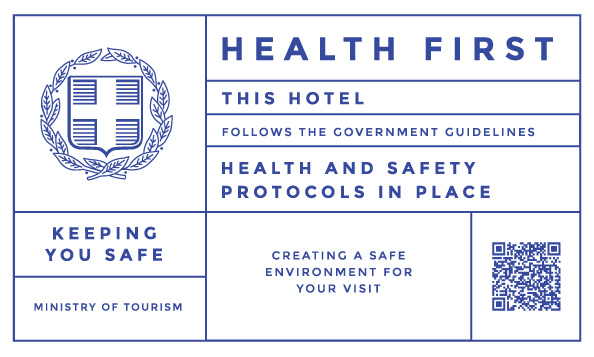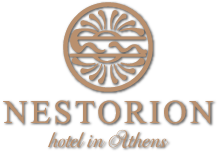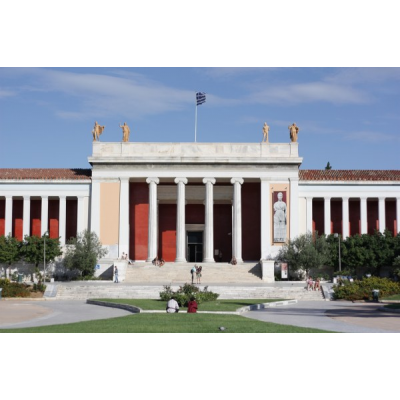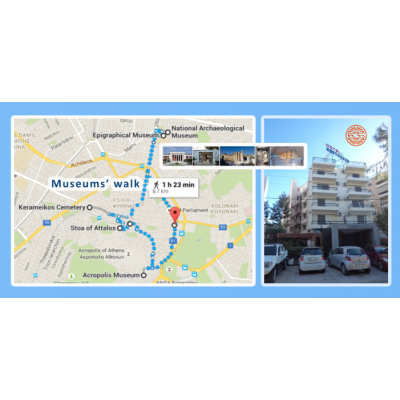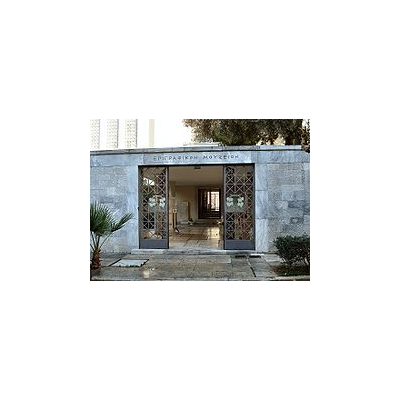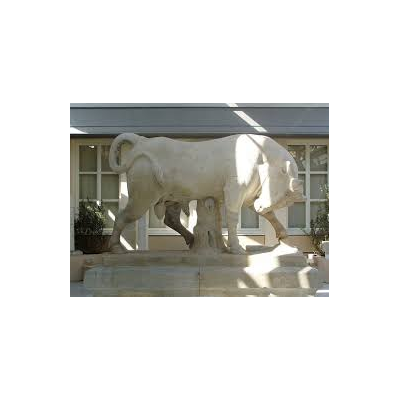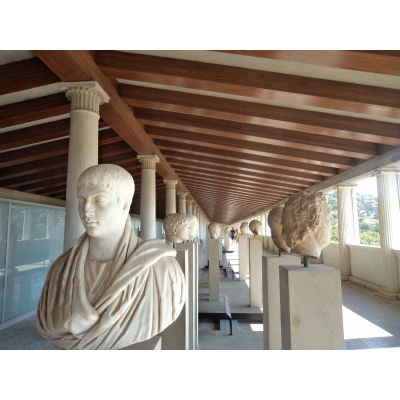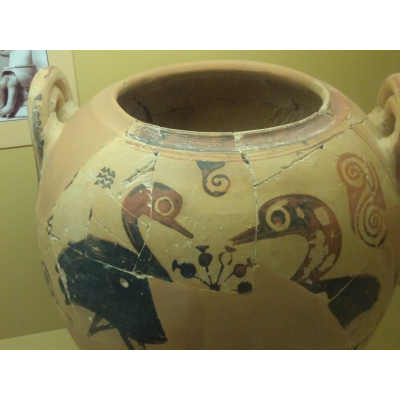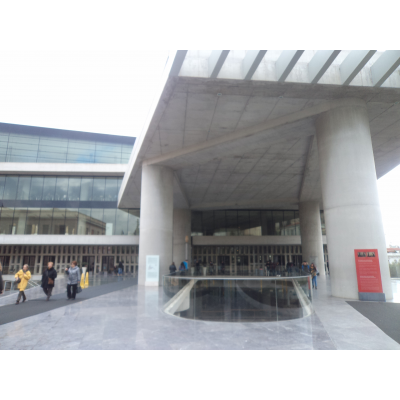Μουσεία Αθηνών
the budget hotel in athens
A walk round the must-see museums of Athens
https://goo.gl/maps/XncUh
1.ARCHAEOLOGICAL COLLECTIONS IN THE METRO
The biggest excavation ever in Greece was carried out at the time of the construction of the metropolitan railway of Athens (1993-2000). Some of the approximately 50.000 finds that were uncovered in these excavations are exhibited in specially designed spaces in the metro stations Panepistimio, Syntagma, Akropoli, Evagelismos and Monasteraki.
http://www.athensattica.gr/en/you-are-here/what-to-see/ancient-sites/item/5430-syntagma-metro-station-archaeological-collection
2. EPIGRAPHICAL MUSEUM
A section of the Archaeological Museum, with a separate entrance (Tositsa 1) Displaying 14.000 inscriptions from Greece and Asia Minor, it is one of the leading museums of its kind in the whole world.. Notice the inscription containing a resolution about about klirotoi (those appointed by lot), from Salamina island - its is the oldest political decision taken in Athens (510-500BC); worthy of notice is also the stele [stone slab] containing a letter of the Roman emperor Marcus Aurelius addressing the Athenians (174-175 BC).
http://athenswalker.blogspot.gr/2014/02/epigraphical-museum-great-museum-not.html
3. NUMISMATIC MUSEUM
It is one of the five most important numismatic museums in the world. It displays more than 600.000 coins, "treasuries" (closed coin collections) standard weights, metals and precious stones, from the ancient Greek period, the Roman period, Byzantium, the western middle Ages, and the modern history.
http://athenswalker.blogspot.gr/2011/08/impressions-from-numismatic-museum.html
4.ARCHAELOGICAL MUSEUM.
A stately building constructed in the late 19th century, the National Archaeological Museum was designed by L.Lange and Ernest Ziller. The Ioanian style propylaea are adorned with clay statues, the copies of the ancient works, while on either side is an oblong arcade. You will find a cafe at the atrium and another one in the beautiful garden in from of the Museum, where many Athenians like to hang out, especially in the summer.
http://www.namuseum.gr/index-en.html
5.KERAMEIKOS MUSEUM
It is located in the archaeological site of Kerameikos. It displays very significant finds of the excavation of Kerameikos, including funeral gifts found in tombs and sculptures adorning tombs of the archaic and classical periods.
http://www.athens-museums.com/guide/history-archaeology/9-museum-of-keramikos
6. STOA ATTALUS MUSEUM
The Stoa of Attalus, a two floor building, was donated by the king of Pergamum Attalus II (159-138 BC) to the city of Athens. It is thought to have been a kind of ancient commercial centre with 21 shops on each floor. The collection of the Museum displays everyday objects, which were unearthed in excavations in the ancient Agora. Visitors may get an idea of everyday life in ancient Athens.
http://odysseus.culture.gr/h/1/eh151.jsp?obj_id=3290
7.HADRIAN S LIBRARY
It is situated north of the Roman Agora (the entrance is on 3 Areos Str.) It is a rectangular building measuring 122mx82m with a Corinthian propylon on the west side. It was built by Roman emperor Hadrian in 132 A.D. It formed a colonnade with specific areas used for the storage of papyruses and books, lecture halls etc. There was a courtyard in the center. In this courtyard an Early Christian Church was built during the 5th century three-aisled basilica and an 11th century single -naved basilica.
http://www.ancientathens3d.com/hadrEn.htm
8. ACROPOLIS MUSEUM
The Acropolis Museum it houses priceless finds from Acropolis monuments that represent its history and function at the most important religious centre of ancient Athens. On the main level, the visitors can see extended remnants of the ancient city, revealed with the excavations that are displayed under the specially-made glass floor, as well as, significant finds deriving from the slopes of Acropolis. On the first level there finds from the Acropolis during the Mycenaean and geometric era, exhibition of archaic items, architectural structures and sculptures from Propylea, from the temple of Athena Nike and Erechtheion, as well as works dating from the late ancient period to the early Christian years. On the second level you can find the restaurant, the Museums shop and book store, balconies with the view of exhibits on the main and first level, as well as a digital media area. Finally on the third level (Parthenon Gallery) are displayed the frieze, the metopes, and the temples pediments. The museum also offers an area for occasional exhibitions and events, an amphitheatre, an internet hall and an information centre.
http://www.theacropolismuseum.gr/en
https://goo.gl/maps/XncUh
1.ARCHAEOLOGICAL COLLECTIONS IN THE METRO
The biggest excavation ever in Greece was carried out at the time of the construction of the metropolitan railway of Athens (1993-2000). Some of the approximately 50.000 finds that were uncovered in these excavations are exhibited in specially designed spaces in the metro stations Panepistimio, Syntagma, Akropoli, Evagelismos and Monasteraki.
http://www.athensattica.gr/en/you-are-here/what-to-see/ancient-sites/item/5430-syntagma-metro-station-archaeological-collection
2. EPIGRAPHICAL MUSEUM
A section of the Archaeological Museum, with a separate entrance (Tositsa 1) Displaying 14.000 inscriptions from Greece and Asia Minor, it is one of the leading museums of its kind in the whole world.. Notice the inscription containing a resolution about about klirotoi (those appointed by lot), from Salamina island - its is the oldest political decision taken in Athens (510-500BC); worthy of notice is also the stele [stone slab] containing a letter of the Roman emperor Marcus Aurelius addressing the Athenians (174-175 BC).
http://athenswalker.blogspot.gr/2014/02/epigraphical-museum-great-museum-not.html
3. NUMISMATIC MUSEUM
It is one of the five most important numismatic museums in the world. It displays more than 600.000 coins, "treasuries" (closed coin collections) standard weights, metals and precious stones, from the ancient Greek period, the Roman period, Byzantium, the western middle Ages, and the modern history.
http://athenswalker.blogspot.gr/2011/08/impressions-from-numismatic-museum.html
4.ARCHAELOGICAL MUSEUM.
A stately building constructed in the late 19th century, the National Archaeological Museum was designed by L.Lange and Ernest Ziller. The Ioanian style propylaea are adorned with clay statues, the copies of the ancient works, while on either side is an oblong arcade. You will find a cafe at the atrium and another one in the beautiful garden in from of the Museum, where many Athenians like to hang out, especially in the summer.
http://www.namuseum.gr/index-en.html
5.KERAMEIKOS MUSEUM
It is located in the archaeological site of Kerameikos. It displays very significant finds of the excavation of Kerameikos, including funeral gifts found in tombs and sculptures adorning tombs of the archaic and classical periods.
http://www.athens-museums.com/guide/history-archaeology/9-museum-of-keramikos
6. STOA ATTALUS MUSEUM
The Stoa of Attalus, a two floor building, was donated by the king of Pergamum Attalus II (159-138 BC) to the city of Athens. It is thought to have been a kind of ancient commercial centre with 21 shops on each floor. The collection of the Museum displays everyday objects, which were unearthed in excavations in the ancient Agora. Visitors may get an idea of everyday life in ancient Athens.
http://odysseus.culture.gr/h/1/eh151.jsp?obj_id=3290
7.HADRIAN S LIBRARY
It is situated north of the Roman Agora (the entrance is on 3 Areos Str.) It is a rectangular building measuring 122mx82m with a Corinthian propylon on the west side. It was built by Roman emperor Hadrian in 132 A.D. It formed a colonnade with specific areas used for the storage of papyruses and books, lecture halls etc. There was a courtyard in the center. In this courtyard an Early Christian Church was built during the 5th century three-aisled basilica and an 11th century single -naved basilica.
http://www.ancientathens3d.com/hadrEn.htm
8. ACROPOLIS MUSEUM
The Acropolis Museum it houses priceless finds from Acropolis monuments that represent its history and function at the most important religious centre of ancient Athens. On the main level, the visitors can see extended remnants of the ancient city, revealed with the excavations that are displayed under the specially-made glass floor, as well as, significant finds deriving from the slopes of Acropolis. On the first level there finds from the Acropolis during the Mycenaean and geometric era, exhibition of archaic items, architectural structures and sculptures from Propylea, from the temple of Athena Nike and Erechtheion, as well as works dating from the late ancient period to the early Christian years. On the second level you can find the restaurant, the Museums shop and book store, balconies with the view of exhibits on the main and first level, as well as a digital media area. Finally on the third level (Parthenon Gallery) are displayed the frieze, the metopes, and the temples pediments. The museum also offers an area for occasional exhibitions and events, an amphitheatre, an internet hall and an information centre.
http://www.theacropolismuseum.gr/en
